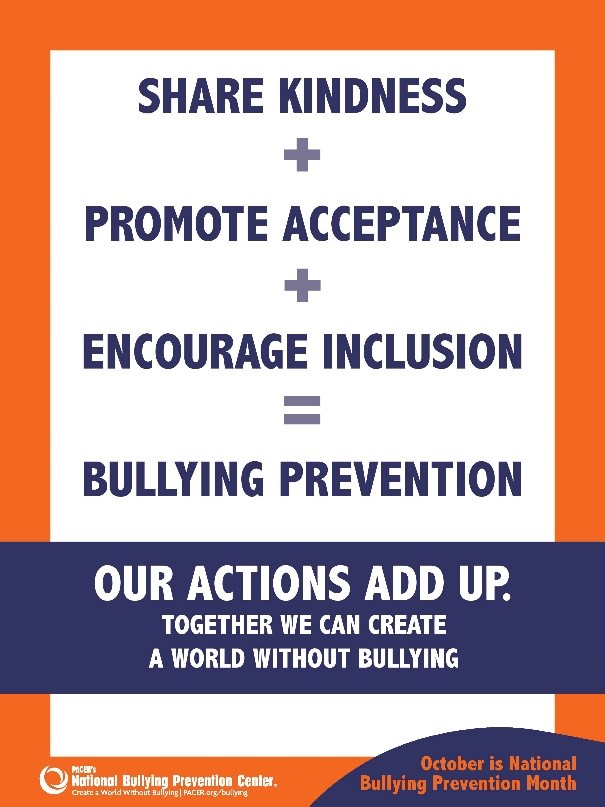One in Three Students Impacted by Cyberbullying
Being bullied is an all too common experience for students. According to the National Center for Bullying Prevention:
- One in five (20%) high school students are bullied on school property
- Nearly half (45%) of middle school students are bullied on school property
- Almost two-thirds (64 percent) of children who are bullied don’t report it
 October is National Bullying Prevention Month, raising awareness and focusing attention on ways to prevent bullying. While much of the focus is on bullying in schools, bullying can take place at home among siblings too and it can have a significant and lasting impact. (See more on sibling bullying.) Bullying can also happen among adults—between adult siblings and in the workplace. (See more on workplace bullying.)
October is National Bullying Prevention Month, raising awareness and focusing attention on ways to prevent bullying. While much of the focus is on bullying in schools, bullying can take place at home among siblings too and it can have a significant and lasting impact. (See more on sibling bullying.) Bullying can also happen among adults—between adult siblings and in the workplace. (See more on workplace bullying.)
Bullying also happens to people of all ages in the digital world. Cyberbullying refers to someone repeatedly and intentionally harassing, mistreating, or making fun of another person online or while using cell phones or other electronic devices.
A 2019 national survey of middle and high school students by the Cyberbullying Research Center found that approximately 37% of the students reported experiencing cyberbullying in their lifetimes. Specific types of cyberbullying experienced most frequently were mean or hurtful comments (25%) and rumors spread online (22%). Approximately 15% of the students admitted to cyberbullying others at some point. Adolescent girls are slightly more likely than boys to have experienced cyberbullying in their lifetimes (39% vs. 35%).
Nearly half of LGBTQ students experience cyberbullying, according to the 2017 National School Climate Survey.
A survey from the Cybersmile Foundation, a nonprofit organization working to address online bullying, looked at various social media platforms and cyberbullying. The survey gathered perspectives of Gen Z teens (ages 13-19) and Millennials (ages 25-34). Instagram was favorite social media of both groups. Instagram and Facebook were identified as the most problematic in terms of cyberbullying (26% each) followed closely by Twitter (24%). Instagram topped the list of most problematic for teens, and Facebook topped the list for Millennials. Pinterest was identified by both groups as the social media platform with the least problem with cyberbullying. Both groups listed TikTok as the social media growing fastest in popularity and ranked it very low for concern about cyberbullying (3%).
Bullying in any form can be harmful, especially to children and youth. Bullying can threaten students’ physical and emotional safety and can cause difficulties with learning. Students who experience bullying are at increased risk for problems at school, sleep difficulties, anxiety and depression, according to the Centers for Disease Control and Prevention. Involvement in bullying in any way—students who are the targets of bullying, students who bully others, and those who witness bullying— may have serious and long-lasting negative consequences for children. A new study links bullying in teen years to structural changes in the brain that can impact mental health.
Many communities are undertaking a variety of approaches to reduce bullying, and school-based bullying prevention programs may decrease bullying by up to 25 percent. Help and resources are available. Here are a few resources:
- Pacer’s National Bullying Prevention Center
- U.S. Department of Health and Human Resources,
- Tips to prevent cyberbullying
- How to document and report cyberbullying - Stompoutbullying.org, resources for students, parents and educators
- Cybersmile Foundation, educational workshops and resources
- Centers for Disease Control and Prevention, The Relationship Between Bullying and Suicide
References
- Cyberbullying Research Center. 2019 Cyberbullying Data. https://cyberbullying.org/statistics
- Cybersmile. 2019. SOCIAL AMERICA: Insights into Millennial and Gen Z attitudes and perspectives toward social media in the U.S. https://www.cybersmile.org/wp-content/uploads/Social-America-Report-The-Cybersmile-Foundation.pdf
- GLSEN. 2017 National School Climate Survey https://www.glsen.org/school-climate-survey
- Quinlan, EB, et al. 2018. Peer victimization and its impact on adolescent brain development and psychopathology. Molecular Psychiatry (2018) https://www.nature.com/articles/s41380-018-0297-9
